The growth of cloud services and hyperscale computing means that more people than ever before are relying on the sheer power and capacity that data centers provide. And consumption of data is growing rapidly as a result of modern behaviour patterns. In April 2020, research found that 50,000 years’ worth of media was live-streamed on one day in the US alone, while globally, the total amount of data created, captured, copied, and consumed is forecast to rapidly increase from 64.2 zettabytes recorded in 2020 to over 180 zettabytes by 2025.
Advancements in artificial intelligence, 5G, video-on-demand and an ever-increasing number of IoT devices adds to the challenges associated with the secure storage and management of vast amounts of data. A maturing of the data center landscape in response has seen two-tier provisions put in place, whereby remote sites are used for archival storage and smaller higher performance facilities deliver immediate response closer to conurbations. In addition, data centers have shifted from an IT support system to a scalable on-demand service to enable businesses and whole economies to keep working and stay connected.
Yet, as data centers grow and are increasingly spread out, monitoring operations and guaranteeing high levels of security can prove challenging. Personnel are under increasing pressure to guard against threats both physical and cyber in nature. Any disruption to operations could prove catastrophic, with periods of downtime having significant cost implications and causing massive disruption to the people and businesses that now rely so heavily on this seamless transfer of data as part of day-to-day living. It is therefore essential that appropriate tools and technologies are put in place to provide comprehensive, overarching protection, and that such solutions are fully scalable as data centers continue to expand and evolve.
A five-layered approach to site security
Physical security solutions such as network video cameras and IP audio solutions can be employed to protect data centers and ensure smoother operation. A five-layered approach covering perimeter, premises, buildings, server rooms and server racks, uses network enabled security products with edge-based analytics, resulting in a truly intelligent solution that offers comprehensive end-to-end protection. Detecting and resolving incidents becomes straightforward, and the potential to apply a range of cameras and sensors give operatives complete peace of mind.
Perimeter protection is intensified by using video surveillance cameras, thermal cameras and radar to detect movement at or near the site, tracking intruders that are approaching on foot or in a vehicle, and even detecting drones within the vicinity. Such technology, driven by powerful analytics, has high levels of accuracy, resulting in fewer false positives and subsequently representing cost savings.
At the premises, access control systems using video surveillance as a second factor of authentication, are employed at all entrance points to identify, authenticate and authorise, with facial recognition analytics also used to manage entry to buildings, rooms, and even individual server racks. Network audio can also play a role in protecting against crime from internal sources, with alarms and alerts triggered by network cameras monitoring for unusual activity within the data center’s many buildings. Such activity might include a server rack being accessed without authorization, staff members acting suspiciously or attempts to access controlled areas at unexpected times.
Cybersecurity and sustainability
With so much data at stake, having a system that is highly secure but also fully scalable as the data center grows is absolutely imperative. Any device that is left vulnerable could be compromised, either by inside threat-actors or those attempting to gain access from outside. These issues can be actively addressed through the hardening of cybersecurity on devices, with firmware upgrades, updates and maintenance tests. Network solutions that offer encrypted communication, IP address filtering, secure boot, and signed firmware will ensure that cybersecurity is not an afterthought, but something that is factored in right from the start.
Power consumption is also high on the agenda for data center managers who will be looking at ways to demonstrate greener credentials, a critical factor when choosing which provider to select. Managers should be looking to employ technology that is designed to operate using low levels of power, reducing the overall energy consumption of the data center’s surveillance systems. In addition, cameras incorporating the latest in edge-based analytics are capable of processing video data within the device itself without the need to continually transfer video across the network for analysis, reducing bandwidth and power consumption.
Scalable and future proof, such modern advancements in security and surveillance technology can vastly improve detection and deterrent capabilities across data center sites. By taking steps now to move towards an overarching and integrated system, data centers managers can improve their security posture to ensure safer storage of vital data, and ultimately, work towards the creation of a smarter, safer world for all.





